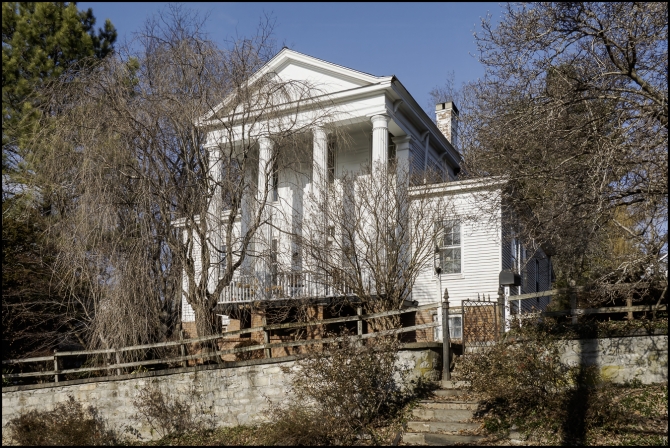The Village of Ossining Significant Sites and Structures Guide (Page 38-39) provides the following information
Street Address: 1 Matilda Street
Architect/Builder: Unknown
Date of Construction: circa 1830s
Architectural Style: Greek Revival (1825-1860)
Greek Revival architecture came to prominence in America during the early 1800’s as part of a renewed phase of interest in the architecture and culture of the ancient Mediterranean following a series of archaeological discoveries in the late 18th century. Greek Revival structures are often identifiable by the use of a temple front façade configuration, with a large triangular pediment and columns dominating the main façade. Some examples of the style may utilize the columns without the pediment, while others may have an appearance consisting of a blend of Greek temple features with other early 19th century styles.
The Charles Snowden House has a temple front and block-and-wing plan, consisting of a two story center portion flanked by a one story wing on each side. Overall, the structure is five bays wide and five bays deep. The main façade’s configuration consists of a temple front design with four two story fluted Doric columns, with six, six over six double hung windows on the center wing flanked by one, six over six double hung window on each of the outer wings. The main entryway featured a shouldered architrave (a classical styled horizontal molding) over the front door. A porch extends along a portion of the main façade, with a second full-length porch located on the rear façade. The house is clad with flush weather board.
Significance: Architectural and Cultural
The Charles Snowden House is architecturally significant as one of three Greek Revival structures still standing in Ossining. The other structures are the James Robinson House and the Smith-Robinson House. This structure is also culturally significant for the series of owners who inhabited the structure, many of whom were influential persons or members of families important to the civic life of Ossining.
The Charles Snowden House, located at 1 Matilda Street, is a Greek Revival structure built by Charles Snowden, the wealthy early 19th century Sing Sing landowner for whom nearby Snowden Avenue is named. Local lore has it that the house was built in approximately 1810, though further
research has shown that it was more likely that the house was constructed between 1830 and 1850. Snowden built the house for his daughter Matilda, and the street on which the house sits is also named for her. The Snowden family sold the house in 1840s and it had a series of prominent owners since then, including:
- Daubney Brandreth, a relative of Benjamin Brandreth, builder of the Brandreth Pill
Factory - Mrs. John Innes Kane, wife of the builder of Kane House
- John O’Brien, owner of the Monument Works factory on Water Street
- John Halpin, Assistant Design Director for the New York Central Railroad
The Charles Snowden House is still used as a residence and retains much of its original historic character today.
Taken with a Sony RX100 MVII.

